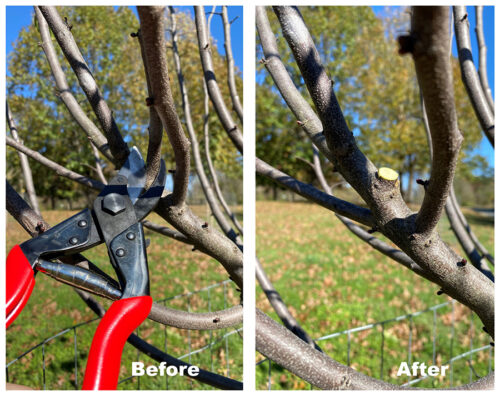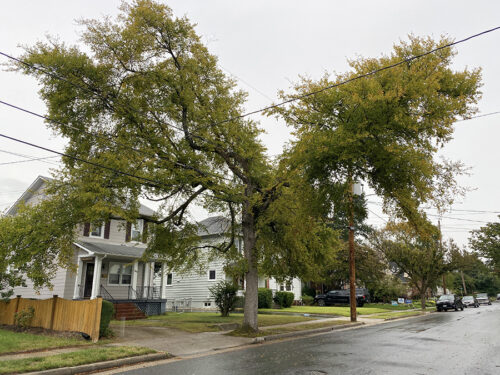Trees are living organisms that require routine maintenance to properly establish and thrive for years to come. The urban environment can be stressful for trees. Factors such as limited growing space, soil compaction, and radiant heat from surrounding buildings and pavement are unnatural for trees to encounter.
Watering
Newly-Planted and Young Trees

Newly-planted and young trees need to be watered regularly.
The crown and roots of newly planted trees are out of water balance – the crown needs more water than the existing root system can supply with normal soil moisture. To compensate for this, newly-planted trees will need watering until they become established.
Newly-planted and young trees should be watered two to three times per week with roughly two to three gallons of water per caliper inch. Example: If a newly planted tree is 2 inches in caliper, the tree should be given 4 to 6 gallons of water at least twice per week during the growing season.
Established Trees
Established trees may need supplemental watering during extended dry periods.
Trees and other plants can display indicators of the need for watering when their leaves wilt. However, wilting can be caused by several things. If you observe wilted leaves, check soil moisture before watering. When a moisture gauge or visual inspection indicates that the top few inches of soil are dry, it is time to water them.
If the soil is not dry, there may be another issue that is causing the plant to wilt. Watering needs for any species will vary based on weather conditions, location, exposure, and time of year.
Proper Watering Practices
- Watering should be in the form of a deep soaking – the objective is to refill the deep reservoir, not to just replenish soil moisture at the top.
- Deep soaking can be done in a number of ways, including using a tree gator, 5-gallon bucket with holes, or other watering mechanism.
- Once the growing season has ended, trees do not need to be watered as frequently. However, trees do benefit from a good soak periodically during warmer winter days.
For additional information on watering in urban areas, please view this informational video
This video is part of a series, Trees for Energy Conservation, developed by the Southern Regional Extension Forestry and Virginia Tech Cooperative Extension with funding provided by a National Urban and Community Forestry Advisory Council grant.

Mulching
Proper mulching is one of the easiest things that can be done to maintain tree health.
Benefits of Mulching
- Helps water to infiltrate.
- Reduces soil temperature and moisture evaporation.
- Suppresses weeds.
- Feeds the soil ecosystem.
- Improves soil structure.
- Aesthetically pleasing.
Mulching Materials
There are a number of products, both organic and inorganic, that are sold as mulch. Ironically, one of the best products is usually free – arborist wood chips fresh off the truck! Note: these wood chips should only be used as a top dressing or surface mulch and not incorporated into the soil because of temporary nitrogen depletion. Other great options are coarse shredded wood mulch and undecomposed leaves.
Finely-shredded, bark, dyed, and inorganic mulches should be avoided. Fine mulches can interlock and form mats that will shed water (rather than allow it to infiltrate) and interfere with oxygen exchange with the soil beneath. Bark is full of waxy substances and shed water rather than absorbing it; this means they will tend to float away or reduce infiltration. At best, inorganic mulches will not feed or contribute to the soil beneath it, and shredded rubber can leach heavy metals as it decomposes.
Proper Mulching – Method Matters
Mulch should be applied to as wide an area as possible. Mulch should never touch the base of the tree because it can cause rot. Fresh wood chips should be applied 4 to 6 inches deep, partially-decomposed wood mulch should be 3 to 4 inches deep, and other mulches 2 to 3 inches deep.
What Not to Do – Volcano Mulching
Volcano mulching is an improper mulching technique where the mulch is piled high against the trunk of a tree and may cause the following:
- Disease and decay due to moisture collection on the trunk
- Failure to develop a normal root flare to help stabilize the tree
- Insect or rodent damage
- Girdling roots
- Creates conditions that can be too damp or too dry for the tree based on the season
Pruning
Pruning on Planting Day
Only focus on pruning out dead, dying, and diseased plant material on planting day.
Prune to fix any structural issue like co-dominant leaders or rubbing branches after the tree becomes established, typically one year per inch caliper at planting. Most newly-planted trees have canopies that are too large for their root systems and need all the energy they can get to grow roots to establish a balance between the two.
Research indicates that the old custom of removing one third of top growth at planting to “compensate” for root loss when transplanting makes it more difficult for the young tree to recover. At transplanting, the tiny absorbing roots are often damaged, but the correct solution is to make sure that the tree receives ample water during the recovery period, NOT to decrease foliage.
Proper Tree Pruning
The best time of year to prune your established tree is in the winter during dormancy. All pruning cuts are an injury to the tree. Pruning should only be undertaken when there is a clear need to meet specific objectives and should follow careful procedures.
- Monitor the tree’s overall health carefully before undertaking pruning of living branches. A stressed tree may not be able to compensate for pruning damage.
- If dead or dying limbs are present, try to determine the cause. Handle pruning carefully, using correct cuts and proper, sharp tools. Sanitize your tools after pruning to make sure you are not spreading any diseases.
- The primary consideration in pruning must be safety. Pruning should be used to remove unsound or poorly-positioned limbs to prevent personal injury or damage to nearby property. These priorities apply to trees of all ages.
- Consult a professional, such as a certified arborist, for assistance in properly pruning your tree.
Learn more information about hiring a certified arborist.
What Not to Do – Tree Topping
Tree topping is the drastic removal, or cutting back, of large branches. It is typically done to correct the problem of a tree outgrowing its space or is in conflict with its surroundings (e.g., interfering with a utility line). This unfortunately creates large, open wounds that subject the trees to invasion by decay organisms, insects, and rot.
Also, the reduction of leaf surface from removed limbs causes damage to the root system, reducing the tree’s ability to absorb the nutrients and water needed for growth. This can compromise the health of the tree, causing premature death of other branches or the full tree.
Additional Resources
- Learn more about plant hardiness zones.
- Learn more about tree planting.
- Learn more about tree identification.
| Image | Title | ID | Description | Content Type | View | hf:tax:document-category | hf:tax:Media |
|---|---|---|---|---|---|---|---|
| A Training Manual for Virginia Tree Stewards 4th Edition – Volunteers for the Community Forest | This training manual includes 10 units, including Tree Anatomy, Tree Physiology, Environmental Factors Affecting Trees, Tree Identification, Tree Selection, Tree Planting and Care, Tree Pruning, Tree Problems and Diagnosis, Invasive Species in Virginia, and Trees and People in the Community. | Publication | View | urban-and-community-forestry | publication | ||
 | How To Kill A Tree | Poster demonstrates the most common mistakes made that negatively impact tree health. Printed copies available. | Publication | View | urban-and-community-forestry | publication | |
| Property Mulching Techniques | Publication explains proper mulching techniques, including type, amount, and method. | Publication | View | urban-and-community-forestry | publication | ||
| Tree Owner’s Manual for the Northeastern and Midwestern United States | NA-FR-04-07 | Manual provides guidance about proper tree care from planting a tree to maintenance and care through the life of the tree. | Publication | View | urban-and-community-forestry | publication | |
| Tree Owner’s Manual for the Northeastern and Midwestern United States | FT0218 | Manual provides guidance about proper tree care from planting a tree to maintenance and care through the life of the tree. Manual produced by USDA Forest Service, cover created by DOF. Limited printed copies available. | Publication | View | urban-and-community-forestry | publication |
Contact Us
For more information or questions, e-mail us or use our contact form.
